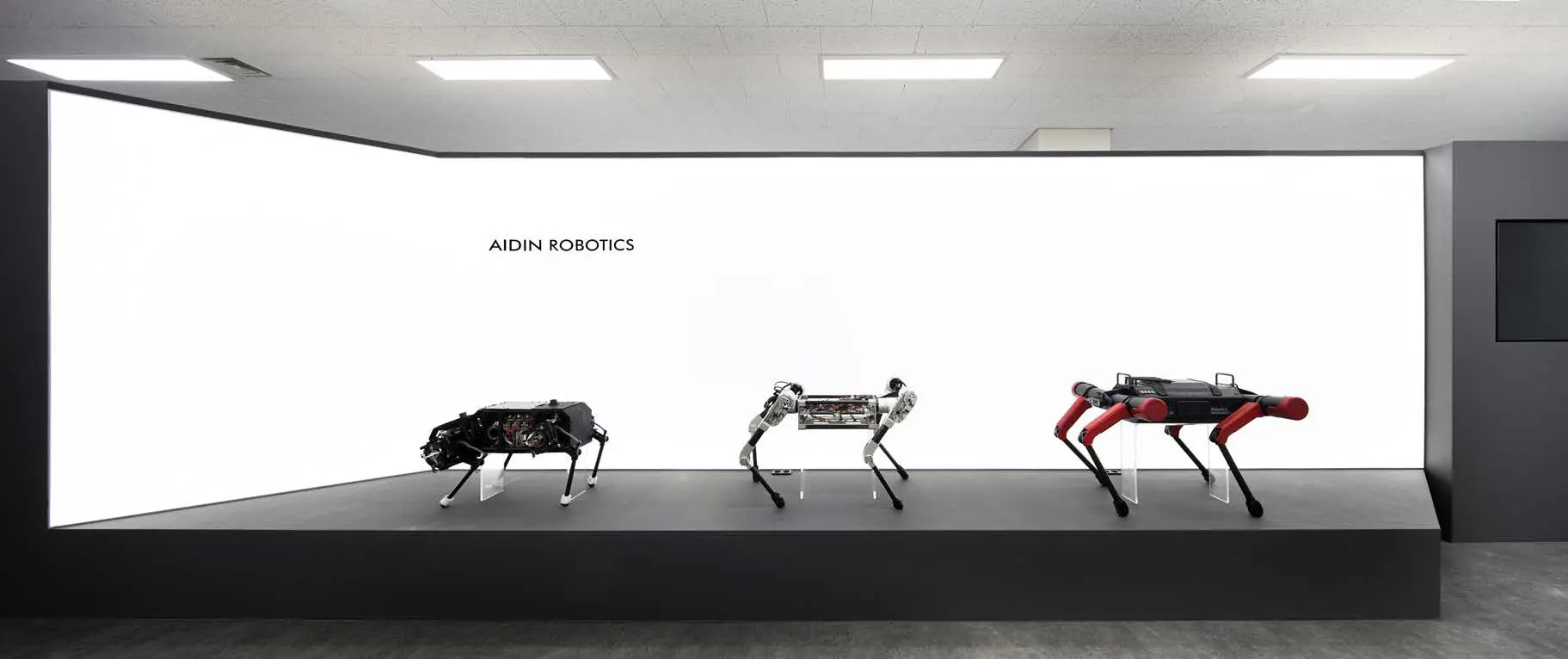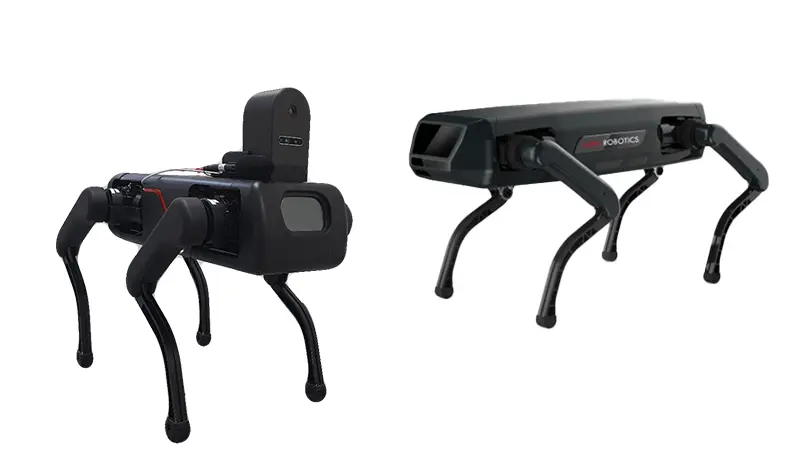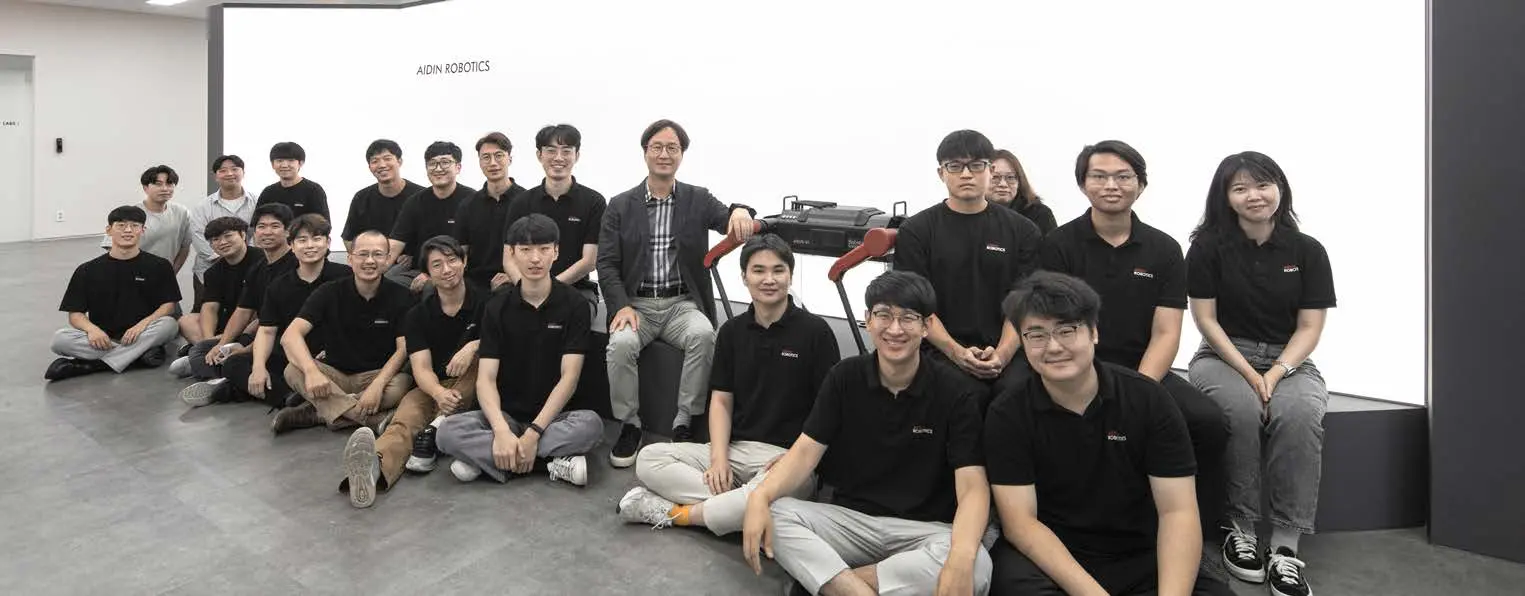
背景
ロボット産業は著しい成長を遂げており、特にサービスロボットの分野では特に需要が増し、多様化も急速に進んでいます。産業用ロボットのセクターは成熟しており、成長はゆるやかになっている一方で、サービスロボットはヒューマノイド型や動物を模した形状など、さまざまなデザインで進化を続けています。清掃、警備、救助、ケータリング、軍事活動など、さまざまな分野に影響を与えることが期待されています。
この変革を牽引する企業のひとつである韓国企業の AIDIN ROBOTICS 社。同社は最近、「ロボット犬」とも呼ばれる四足歩行ロボットを発表しました。このロボットには AksIM-2 アブソリュートエンコーダが搭載されており、AksIM-2 による位置情報のリアルタイムフィードバックが滑らかな動作と精密な制御を支えています。
四足歩行ロボットは通常、本体、モータ、減速機などの機械部品、位置、速度、トルクなどのフィードバックデータを得るためのセンサーそしてロボットの「頭脳」として動作を制御するコントローラから成ります。
課題
四足歩行ロボットにとって大きな課題のひとつに、バランスの維持と動的制御があります。バランス能力と動的性能が優れていれば、歩行、走行、ジャンプ、登はん、階段の昇降、転倒後の起き上がり、跳躍など、さまざまな動作を実行できます。これらの能力は、関節の動きの性能、動作制御の品質と安定性、そして制御則に依存しています。
すなわち、ロボットは全身の協調動作とコンプライアント制御を実現するために、動作制御システムと制御則に依存しているとも言えます。関節の位置、速度、加速度などのデータは、ロータリエンコーダを通じてコントローラにフィードバックされる必要があり、このフィードバックは、四本の脚の動き、移動方向、速度を正確に制御するために不可欠です。
AIDIN 社の四足歩行ロボットは、脚による自走が可能なロボットであり、階段、険しい地形、曲面なども苦にせず移動します。用途に応じてモジュラ式に装備を換装可能であり、爆発物処理や化学物質・放射性物質で汚染された環境など、過酷な状況下で人間の代わりに作業を行うことができます。

AIDIN ROBOTIC 社の四足歩行ロボット
解決策
各脚には、股関節のロール、太もものピッチ、ふくらはぎのピッチを制御する 3 軸の回転関節が搭載されており、最大 60°の可動範囲を有しています。この構成により、4 本の脚で合計 12 自由度の回転運動による、実際の四足動物のような動きが可能となっています。各関節はモータによって駆動され、それぞれに実装された AksIM-2 ロータリアブソリュートエンコーダによって動作中の回転角度がフィードバックされます。計 12 個のエンコーダが組み込まれています。
安定性と信頼性の高いエンコーダは、ロボットの位置精度や動作制御能力の大幅な向上に寄与します。また、動的な負荷の検出やモータの過負荷防止にも不可欠であり、ロボットの安全性と安定性の向上という役割もあります。
四足歩行ロボットにおいては、最初の姿勢が全体の動作制御にとって非常に重要です。コントローラがロボットの現在の姿勢を計算し判断するには、各関節の位置を把握する必要があります。この目的のために、AIDIN 社が動作制御設計におけるコンポーネント選定の段階で指定したのがアブソリュートエンコーダでした。アブソリュートエンコーダの主な利点としては、インクリメンタルエンコーダのように電源 OFF しても現在位置を消失することがないため、電源 ON 後に基準位置に戻る不要な待機時間を最小限に抑えられることが挙げられます。
加えて、重要な要素として、リングスケールが中空設計であることが挙げられます。中空であることで、中央部に大量のケーブルを通すことができるからです。また、設計においては、関節モータによって発生する磁場が磁気式エンコーダに干渉し、誤った読取りを引き起こす可能性についても考慮する必要があります。
“RLS' RLS の AksIM-2 シリーズは、ロボット向けに特化された回転エンコーダであり、私たちのすべての要求を満たしています。自動キャリブレーション機能が搭載されており、この機能を使うことで取付けの質が高まり、より安定かつ信頼性の高い動作制御が実現しました。非常に印象的な特徴です”
AIDIN 社の研究開発部門で Chief Technology Officer を務める Kim Yong Bum 氏
現在、AIDIN 社は分解能 20bit、通信プロトコルとしては SSI および BISS-C の AksIM-2 を採用しています。
結果
AksIM-2 の動作温度範囲は−40℃~+105℃で、衝撃および振動に対して高い耐性を有します。また、回転中に偏心で生じる誤差を除去する自己キャリブレーション機能を搭載しています。偏心はエンコーダの精度に影響する主要な要素のひとつであり、多くの場合で磁気リングのずれが原因で発生します。
また、AksIM-2 には、内部パラメータを常時チェックする自己モニタリング機能が搭載されており、内蔵 LED の点灯パターンからエラーや警告といったステータスに関する情報を判断することができます。
四足歩行ロボットの場合、動作中に発生する慣性は人間の歩行時のそれに似ており、制御則の設計を複雑化させる非線形的な特性をもたらします。そしてロボットが重くなるほど、慣性も大きくなります。この課題に効果的に対処するために、ロボットの関節は極力コンパクト化かつ軽量化する必要があり、同時にコンパクトで軽量なエンコーダが必要とされます。
AksIM-2 はロボットシステムへの組み込みを前提に設計されたエンコーダです。プリント基板であるリードヘッドと、中央に貫通穴があいた磁気リングから成るため、モータに直接取り付けることができ、ロボットの限られたスペース設計に理想的な選択肢となっています。
今後の目標
Kim 博士は次のように述べています。“将来的には、四足歩行ロボットにエンコーダ 1 個を入力側に、もう 1 個出力側に配置する、デュアルエンコーダ設計の採用を検討しています。両方のエンコーダから得られる位置情報や速度データ、さらに駆動電流やモータのトルクの出力を比較することで、関節に作用する外力の大きさを評価することができ、それによってロボットを安全に制御できるようになります”

AIDIN Robotic's team
AIDIN ROBOTICS 社について
AIDIN 社は、韓国の Sungkyunkwan University の Department of Mechanical Engineering にある Robotics Innovation Laboratory から誕生した企業です。四足歩行ロボットなどのロボットソリューションの開発と提供に注力しています。
詳細については、AIDIN ROBOTICS 社の Web ページをご覧ください。"


